Ride, Brave Pegasus-Pony! Ride!
Coaster Rider is based on Pegasus, an actual roller coaster in Germany’s Europa-Park. It was created by yoyogames.com member Bl@ckSp@rk. It’s a great game and in concept it is comparable to Line Rider, but with a tangible goal.
Deceptively Simple
The goal of Coaster Rider is deceptively simple; all you have to do is draw a track to get the roller coaster from its starting position to a checkered flag somewhere on the map. The catch is that, on your way to this flag, you must collect a number of stars placed around the map. In the first couple of levels this is a fairly simple task; the intended path to the end is fairly cut out by the position of the stars, but by the third level, the game will begin to test your mettle, and it doesn’t get easier through the rest of the ten levels.
Energy In, Energy Out
Coaster Rider is predominantly a game about conservation of energy. In most levels the amount of potential energy you start with is all you have to work with. Because of this, you’ll find yourself constantly tweaking and redrawing sections of the track in order to conserve more energy so you can make it up the next hill. In some levels, however, there are speed boost power-ups which help by adding more energy to the system. It’s up to you how you utilize this energy.
Trial and Error
Tracks in Coaster Rider are not made up of pre-built pieces, but rather they are drawn in a fashion similar to Line Rider. Because of the open-ended nature of track design, there is a huge emphasis on trial and error. Most things you build will not work perfectly the first time, so you will spend a lot of time redesigning the track.
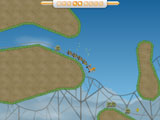
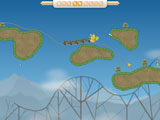
(Coaster Rider Game Screenshots)
Minor Complaints
Rather than the line drawing being completely fluid, it seems to be made up of small line segments, which can sometimes make drawing certain track layouts a pain, with sharper angles in comparison to smoother curves. It also would have been nice to have some sort of “undo” feature for when an “improvement” actually turns out to be detrimental to your track design. There is a save feature, however, which serves the game well enough.
Another minor way to improve the game would be a fast-forward function. Some of the levels’ tracks can become rather lengthy, and having to watch the entire ride over and over can become annoying when all you have to redesign is the very end of the track. Also sometimes the coaster will have just enough momentum to make it over a hill, which can take a long time as well, as you wait for it to slowly inch its way over the top and and down the other side. Being able to speed up the playback of the coaster would have helped with this.
A Fun Ride
Coaster Rider is a blast to play. You’ll most likely be hooked instantly, and it will probably take you a few days to beat, even with just 10 levels. It’s free and can be downloaded at:
Download Coaster Rider (12.2 MB)
Related Posts:
- 7 Children Die in Tragic Roller Coaster Accident
- Line Rider, America’s Favorite New Hobby
- Line Rider Coming to Consoles!
- News Roundup: Three Excellent Physics Toys
- List of Physics Games
Barrel of Fun? Or Barrel of Frustration?
Most physics-based puzzle games involve getting an object (it’s usually round) from point A to point B. The physics model – gravity, inertia, friction – handles most of the moving. Working out how to make the physics do what the player wants is the puzzle. Reaching that solution is a kind of experimentation. Look at the puzzle, imagine a possible solution. Patch it together using the tools the game provides. Press the “start” button, observe what happens. When something goes wrong, make modifications. Eventually, this process of observing and refining leads to the true solution.
Which brings me to CGS Software’s Barrel Mania.
Big Puzzles
The critical object in Barrel Mania is, of course, the barrel. Like most physics game lynchpins, it rolls, bounces, and falls. It’s blown up by a variety of hazards, from lava pits to mines. To make sure it isn’t destroyed on the way to its destination, the player is given a number of “gadgets”. These stick-like objects can be drawn anywhere at any angle, serving as platforms, ramps, and rails.
The player gets a bunch in each stage. The stages are enormous, usually several screens in length and width. The player is scored on how many pieces are left unused at the end, like in most physics puzzle games. However, the game’s secondary goal is to collect stars, which are scattered in difficult-to-reach nooks in each stage. To reach all of these stars, the player can’t be shy about using lots of gadgets. Barrel Mania encourages the player to build big.
It’s not a game of quick flashes of insight, but one of dedicated building and measured progress. Huge stages need to be mentally broken down and worked on one a piece at a time. The reward for a slow, dedicated effort is the sight of a vast, seemingly insurmountable landscape slowly transforming into a neat pathway of rails. The only way through is experimenting, observing the results, and refining a solution until it works.
Unlucky Breaks
What makes working out that solution difficult is a surprising amount of randomness in the game. I can run the same experiment twice and get two different results. On one try the barrel might get to the goal; on another, it might bounce into a pool of lava. One time the barrel might grab every star; the other time, it might miss one. It makes the game more exasperating than it needs to be. It’s hard to refine a solution based on the results of a test run if those results can’t be counted on. In a physics-based puzzle game, physics should be more important than luck.
There are also timing-based objects that exacerbate the problem. Some stages have lasers that fire periodically, sometimes missing the barrel, sometimes destroying it instantly. Worse are the spinning platforms, which might be in any position by the time the barrel reaches them. In the ten demo stages I played, I tried to avoid the spinners as much as possible by directing barrels around them. When contact was unavoidable, I built funnels that would compensate for a variety of possible outcomes. It feels sloppy and inefficient. What’s unfortunate is that the simple solution would have been to have all the objects in a stage reset to their starting positions each time the experiment is run.
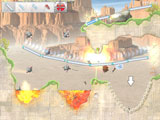
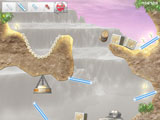
(Barrel Mania Game Screenshots)
How Many Barrels Do You Really Need?
Despite an identical premise to a number of games which came before it, Barrel Mania caters to players who want larger problems to wrestle with. For twenty dollars, though, it’s hard to overlook the jarring presence of luck in a game about controlled experimentation when there are so many other games about exactly the same thing.
Download Barrel Mania (24.9 MB)
Related Posts:
- List of Physics Games
- Trials 2SE Visual Upgrade, Same Great Physics
- Great-Looking Motorcycle Game, But Is It Fun?
- Interview: Peter Stock, Armadillo Run
- Interview with Matthew Wegner (Fun-Motion.com)
Slow-Mo Stick Figure Fighting
For those not familiar with the “demo scene,” there are many competitions where programmers (or programming groups) will get together and see what they can do with severe size, time, and system restraints. Sometimes they produce music, sometimes fantastic visual effects or even short CG films. In this case, developer “Hikey” has produced a ragdoll fighting game that won second place at the Breakpoint 2007 demo competition.
Simple Concept
This is a fighting game without a punch or a kick button – your persona automatically adjusts to the classic stickman pose. If a hand or a foot touches an enemy, the joint springs forward and hits the opponent.
Movement is also handled very simply; the arrow keys on the keyboard apply force to your stickman’s head. There is no restriction to jumping height (you can fly perpetually), and your momentum is only countered by the walls at the edge of the screen.
What results is surreal–your character is sailing around on the screen in what appears to be a scene only possible in The Matrix–but it’s this freedom that makes it so much more fun.
Create Your Own Moves
One of my favorite side-effects of a physics-modelled game is you don’t need to teach people how to throw a hard punch. When you only have control over the motion of your head, you’ll soon find a few different ways to get your arms and legs whipping around you to deal smashing blows to your opponents. You’ll work out neat moves you can do by springing yourself off the ground or nearby walls. The faster you are moving, the more damage you deal.
TMNP also incorporates a few seconds of slow motion every time you score a hit. Apart from looking really cool, it also gives your stickman a bit of a speed boost. If you use your slow motion time wisely by winding up for another barrage of blows, you’ll do that much more damage.
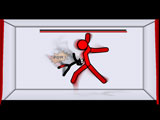
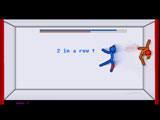
(Teenage Mutant Ninja Puppets Game Screenshots)
Mindless Fun
I found myself playing through the first few levels with relative ease, but was happy to see that the difficulty does actually ramp up quite a bit, forcing you to try out and learn new moves and tactics. And when you get stuck (did anyone defeat Mr. Ninja?), there’s a sandbox mode where you can pit yourself against 50 enemies and arm yourself with a chain or nunchucks.
Being a competition-designed 96Kb game, it didn’t exactly go through a thorough quality assurance program. Yes, it has it’s share of bugs and sure it has potential to be so much more than what it is. Despite the drawbacks, it is still worth downloading… even if it’s just to try out the bull-whip.
I do have one complaint, though–why the horrible name?
Download Teenage Mutant Ninja Puppets (68 KB)
Related Posts:
« Previous Page — Next Page »


 (Rate this game! 119 votes, average: 3.67 out of 5)
(Rate this game! 119 votes, average: 3.67 out of 5) My name is Matthew Wegner, and this site is dedicated to physics games.
My name is Matthew Wegner, and this site is dedicated to physics games.